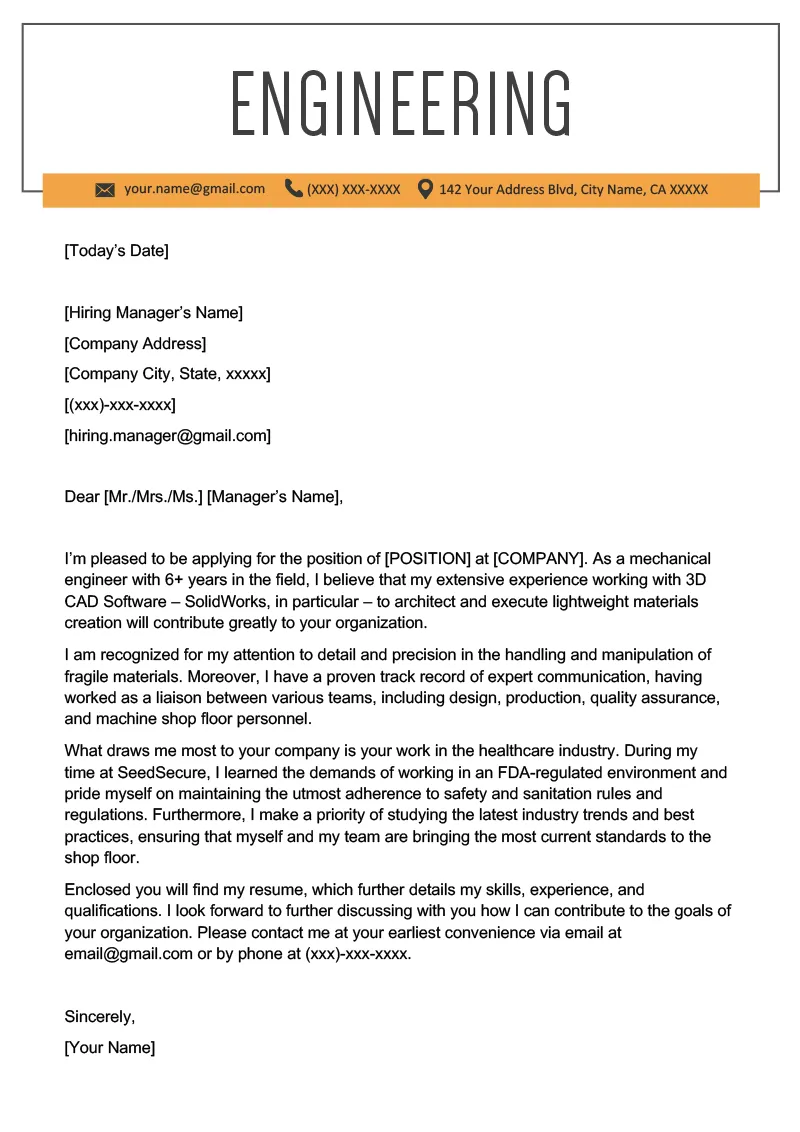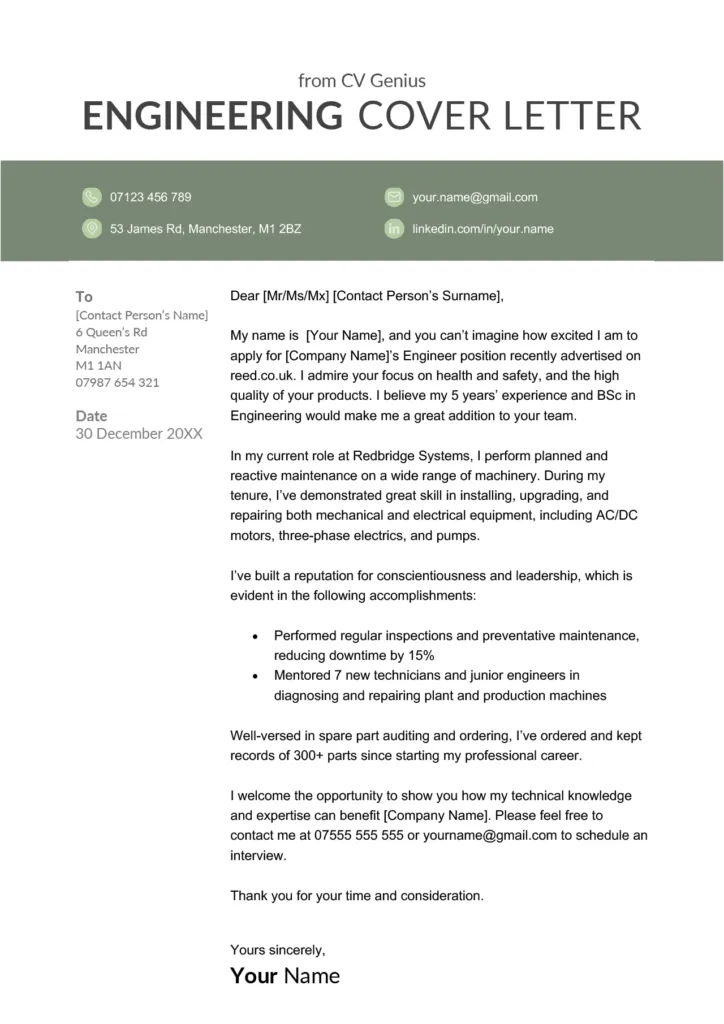Understanding the Engineering Cover Letter
An engineering cover letter is a crucial document that accompanies your resume when applying for engineering positions. It serves as your introduction to the hiring manager, providing context to your application and highlighting your relevant skills, experience, and enthusiasm for the role and the company. Unlike a resume, which is a factual summary, the cover letter allows you to express your personality and explain why you are the ideal candidate. It is your opportunity to make a strong first impression and persuade the employer to read your resume and consider you for an interview. A well-written cover letter can significantly increase your chances of landing an interview.
Why a Cover Letter Matters for Engineers
In the competitive field of engineering, a cover letter can be the differentiating factor that sets you apart from other applicants. It provides a platform to expand on the information presented in your resume and demonstrate how your qualifications align with the specific requirements of the job. It offers an opportunity to explain career gaps, transitions, or any other information that might need clarification. Furthermore, it helps you personalize your application, showcasing your genuine interest in the company and the position. Many hiring managers consider a cover letter essential, and not submitting one can automatically disqualify you from consideration. Engineering is a field that demands attention to detail, a well-crafted cover letter proves your professionalism and commitment to excellence.
The Role of a Cover Letter in the Application Process

The cover letter’s primary role is to capture the hiring manager’s attention and encourage them to delve deeper into your application. It acts as a marketing tool, where you sell your skills and experience. The cover letter also showcases your communication skills, an important attribute in engineering. It provides a space to tailor your message to the specific job and company, highlighting your understanding of their needs and how you can contribute. By clearly articulating your value proposition and expressing your enthusiasm, you position yourself as a strong candidate and increase the likelihood of securing an interview. The cover letter is the first impression. Make it count.
Key Components of a Successful Engineering Cover Letter
A well-structured cover letter is organized, clear, and concise. It follows a standard format while allowing for personal touches. The main components work together to present a compelling case for your candidacy. Each section should be focused, highlighting the most relevant information and avoiding unnecessary jargon or fluff. A strong cover letter showcases your expertise and passion for engineering.
Contact Information and Salutation
Begin your cover letter with your contact information: your name, phone number, email address, and optionally, your LinkedIn profile URL. This ensures the hiring manager can easily reach you. Following this, include the date and the hiring manager’s name and title, if available. Addressing the letter to a specific person demonstrates that you have done your research and taken the time to personalize your application. It also shows respect and professionalism. If you can’t find a specific name, use a professional salutation like “Dear Hiring Manager”.
How to Address the Hiring Manager

Whenever possible, address your cover letter to a specific person. This demonstrates your initiative and attention to detail. Research the company’s website, LinkedIn, or other professional platforms to identify the hiring manager or the person responsible for reviewing applications for the specific role. Using a person’s name creates a more personalized and engaging letter. If you are unable to find a name, a general greeting like “Dear Hiring Manager” is acceptable.
The Opening Paragraph
The opening paragraph is your chance to grab the reader’s attention. It should immediately state the position you are applying for and how you learned about the opportunity. Briefly mention your key qualifications and your enthusiasm for the role. The opening should be concise and compelling, making the reader want to continue reading. Consider starting with a strong statement about your skills or mentioning a specific accomplishment that aligns with the job requirements. This sets the tone for the rest of your letter and highlights why you are a great fit.
Grabbing Attention and Stating Your Purpose
Start with a strong, attention-grabbing statement that reflects the company’s mission or a recent project related to the job. Then, clearly state the position you are applying for and where you found the job posting. This allows the reader to quickly understand the purpose of your letter. For example, “I am writing to express my interest in the Mechanical Engineer position advertised on your company website.” A strong opening paragraph sets the stage for a compelling narrative.
Highlighting Your Skills and Experience

The body of your cover letter should focus on your relevant skills and experience. Tailor your content to match the job description, highlighting the key requirements and demonstrating how you meet them. Use specific examples to illustrate your abilities and achievements, quantifying your results whenever possible. Show, don’t just tell the reader about your skills; provide concrete evidence of your capabilities. This helps the hiring manager understand your value and how you can contribute to their team.
Quantifying Achievements with Data
Whenever possible, use data to quantify your achievements. This adds credibility to your claims and provides tangible evidence of your accomplishments. Instead of saying “Improved efficiency,” state “Improved project efficiency by 15% through the implementation of lean manufacturing principles.” This demonstrates your ability to drive results and make a measurable impact. Numbers make your achievements more compelling and give the hiring manager a clear understanding of your value.
Showcasing Relevant Projects
Describe relevant projects in detail, focusing on your role, the challenges you faced, and the results you achieved. This allows the hiring manager to understand your practical experience and problem-solving abilities. Mention the technologies you used, the specific engineering principles you applied, and the impact your work had on the project’s success. Tailor the project descriptions to align with the job requirements and the company’s needs. Showing your practical experience builds trust and confidence.
Tailoring Your Letter to the Job Description

Carefully review the job description and tailor your cover letter to highlight the skills and experiences that match the requirements. Use the same keywords and phrases as the job posting. This shows that you understand the role and the company’s needs. Avoid a generic cover letter and instead, create a customized document that demonstrates your understanding of the specific requirements. Highlighting the relevant skills makes your application stand out.
Demonstrating Your Enthusiasm for the Company
Showcasing your enthusiasm for the company is critical to a successful cover letter. It shows the hiring manager that you are genuinely interested in the opportunity and have invested time and effort in learning about the organization. Research the company’s mission, values, recent projects, and industry standing. Use your findings to express your interest in the company and how you can contribute to their success. A demonstrated interest shows you want to be part of the company.
Researching the Company Culture
Before writing your cover letter, conduct thorough research on the company. Understand its mission, values, and culture. Explore their website, social media profiles, and news articles to gather information. Mentioning specific company initiatives, projects, or values demonstrates your genuine interest and shows that you are a good fit. Tailor your language and examples to reflect the company culture. The more you know, the better you can demonstrate your interest.
Expressing Your Interest in the Role

Clearly express your interest in the role and explain why you are excited about the opportunity. Mention specific aspects of the job that appeal to you and how your skills and experience align with the requirements. Explain what motivates you and what you hope to achieve in the position. This genuine enthusiasm shows that you are invested in the role and eager to contribute. Your excitement will make you memorable.
The Closing of Your Engineering Cover Letter
The closing of your cover letter should reiterate your interest and provide a call to action. Express your gratitude for the reader’s time and consideration. Use a professional closing and ensure your contact information is readily available. Proofread carefully for any errors, ensuring the letter leaves a positive final impression.
Call to Action and Thank You
In your closing paragraph, reiterate your interest in the position and express your gratitude for the hiring manager’s time and consideration. Include a call to action, such as “I am eager to discuss my qualifications further in an interview.” End with a professional closing, such as “Sincerely” or “Best regards”, followed by your full name. Ensure your contact information is clearly visible, making it easy for the hiring manager to reach you. This shows courtesy and eagerness.
Proofreading and Formatting Tips

Before submitting your cover letter, carefully proofread it for any errors in grammar, spelling, and punctuation. Ensure that your formatting is consistent and professional. Use a clear and easy-to-read font, such as Arial or Times New Roman, and maintain consistent spacing. Proofreading and formatting errors reflect poorly on your attention to detail, so take the time to ensure that your letter is polished and professional. A well-formatted letter shows your commitment to quality.
Common Mistakes to Avoid
Several common mistakes can undermine the effectiveness of an engineering cover letter. Avoid these pitfalls to increase your chances of success. Ensure your letter is customized, free of errors, and focused on the job requirements.
Generic vs. Specific Cover Letters
Avoid using a generic cover letter. Tailor your letter to each specific job application, demonstrating your understanding of the requirements and the company’s needs. Generic letters often fail to capture the hiring manager’s attention. Taking the time to customize your letter shows your interest and commitment. Focus on specific projects, skills, and experiences that match the job posting. Tailoring your letter increases your chances of success.
Typos and Grammatical Errors
Typos and grammatical errors can create a negative impression and damage your credibility. Proofread your cover letter carefully, checking for errors in spelling, grammar, and punctuation. Consider having a friend or career advisor review your letter as a second pair of eyes. The errors show lack of attention to detail. A polished, error-free letter shows professionalism and attention to detail.
Formatting Issues
Ensure your cover letter has a professional and consistent format. Use a clear and easy-to-read font, such as Arial or Times New Roman, with a font size between 10 and 12 points. Maintain consistent spacing and margins. Avoid excessive use of bolding, underlining, or italics. Poor formatting can make your letter difficult to read. A well-formatted letter shows attention to detail and professionalism.
Final Thoughts
Writing an effective engineering cover letter requires careful planning, attention to detail, and a genuine enthusiasm for the role and the company. By following these guidelines and avoiding common mistakes, you can create a compelling cover letter that showcases your skills, experience, and passion, increasing your chances of landing an interview and securing your dream job. Remember that your cover letter is an opportunity to make a strong first impression. Invest the time and effort to create a document that represents you and your qualifications in the best possible light. Good luck with your job search!
